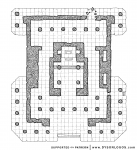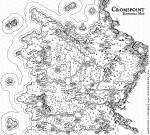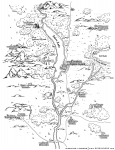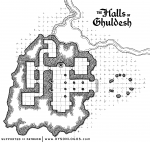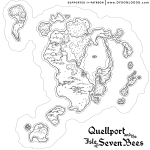
A small settlement in the Thendrake Archipelago, Quellport sits on an unusual lagoon in a cluster of islands. Except for the Isle of Seven Bees (the elongated forested island to the upper left of the map), all the smaller islands are generally just referred to as Quellport or the Quell Islands.
There are a total of four settlements on the Quell Islands as well as a number of towers and smaller edifices –
Quellport itself is essentially in the centre of the map sitting on the gentle waters of the lagoon. With a population of about 1,400, Quellport has grown beyond being a fishing and farming community and supports several churches, guilds, and a “tower of arcane knowledge” where a number of wizards and a few clerics who make excursions out to the cube for research or spiritual reasons.
Quiet Cove on the north side of the same island as Quellport. A small fishing community built up around a couple of large manors established by well-off ex-adventurer types.
Sheep’s Cay on an eastern Quell island specializes in deep sea fishing and also maintains a friendly relationship with the cyclops living in the caves a few islands north of them. They deliver the occasional sheep and large fish to the cyclops, and the cyclops remains generally peaceful in return.
Greenshore is south of Quellport and is known for the excellent shipbuilders who set up their business here. They collect wood from the island across from them and build some of the hardiest fishing and merchant vessels in the region.
The Isle of Seven Bees is home to a strange and massive hive that sits atop a 300 foot amber tower. A number of giant bees (about 20 feet long) live within the hive and occasionally fly over nearby islands. At random intervals every few years or so, they collect upon the cube in the Quellport lagoon – and a local adventurer has regaled visitors and locals alike with tales of liquid gold and other treasures he found within the hive when all the bees were at the cube a few years back.
And finally the cube… In the middle of the Quellport lagoon is a massive cube, sitting at a slight angle in the waters. A deep blue in colour, it seems potentially related to the massive pillars of the “City of Blue”. Small bits of it have been mined and broken off, but those who work the cube itself for more than a few hours find themselves sickening and often dying within a week or two. It is said that whatever god who dropped their die here doesn’t like it when the locals try to break it apart.
https://dysonlogos.blog/2019/02/28/quellport-and-the-isle-of-seven-bees/